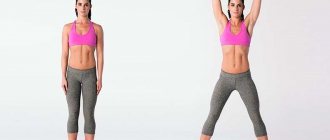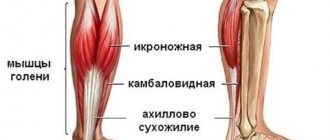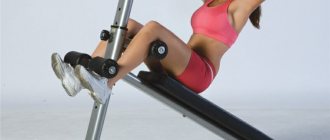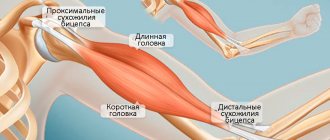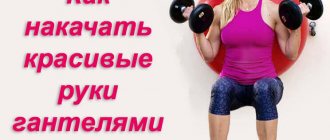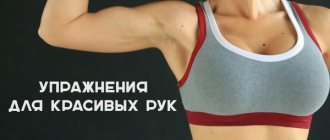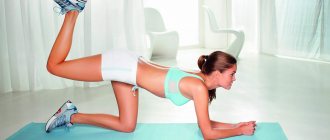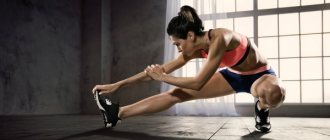© zamuruev — stock.adobe.com
Share:
What you need
- Barbell
- Dumbbells
- Exercise equipment
The leg muscles are the largest in the human body. Quadriceps exercises are performed by representatives of almost all sports disciplines. Without these exercises, you cannot achieve strength, mass, or endurance in your legs and body as a whole. The article discusses the best basic and isolated movements for the quadriceps for men and women, and presents training programs for boys and girls.
Anatomy of the quadriceps
The quadriceps (quadriceps femoris muscle) includes four muscle bundles:
- the vastus lateralis muscle is the largest bundle, participating in all movements associated with extension of the knee, and forming the lateral region of the thigh;
- vastus medialis (“droplet”) – also involved in movements associated with extension of the knee joint and is responsible for the formation of a rounded, full frontal surface of the knee;
- vastus intermedius muscle - located between the two previous bundles, actively involved in the work during extensions, squats, jumping, running;
- The rectus muscle is the longest bundle that gives the thigh a rounded shape, it is used not only in extension, but also in flexion, the only area of the quadriceps that is not directly attached to the femur.
© HANK GREBE - stock.adobe.com
To one degree or another, all areas of the muscle group in question are involved in the exercises described below. The quadriceps is responsible for the stability of the body in an upright position, ensures the movement of the lower leg in the knee joint, promotes tilting of the pelvis and pulling the legs towards the stomach.
Features of working with quadriceps
Correct technique plays a huge role in the work of the quadriceps. The health and condition of the knees and lower back depends on it. By sinning with the technique of performing exercises, the athlete transfers the main load to other muscle groups.
Like all large muscles, the quadriceps muscle takes a long time to recover. In most cases, there is no point in training it more than once a week . An option with two leg workouts is allowed, but then they are separated: the first one works the quadriceps, the second one works the back of the thigh.
The basis of the training program should be basic (multi-joint) exercises. They are designed for mass and strength, as they load the legs and body in a complex manner. Isolated movements help to detail the muscles, give them a “cut,” and can also be used to warm up before heavy compound exercises.
For this reason, in the first few years of systematic training, you need to focus on the “base”. And only then, having gained mass and strength, you can start polishing your legs. This doesn't mean that beginners should ignore single-joint movements. They are also needed, but priority is given to the basic ones. This also applies to women seeking to lose weight and have a striking silhouette. Basic movements performed in a high-repetition style are the main secret to success.
Read also[edit | edit code]
- Muscles - anatomy and functions
- Leg muscles
- Hamstring muscles
- Legs - exercises and training features
Muscles around the hip joint
- Gluteus maximus muscle
- Sartorius
- Iliopsoas muscle
- Gluteus medius muscle
- Gluteus minimus
- Tensor fascia lata
- Pectineus muscle
- Adductor muscles
- Adductor longus muscle
- Adductor brevis muscle
- Adductor magnus muscle
- Gracilis muscle
- Superior gemellus
- Gemini inferior muscle
- Obturator internus muscle
- Obturator externus muscle
- Piriformis muscle
Quadriceps exercises
There are hundreds of leg exercises. There is no point in listing everything: those described in the article are more than enough. Moreover, most movements are variations of the basic ones.
Basic
This section describes the main exercises for the quadriceps. Beginners often try to stay away from them, but without a “base” they are nowhere.
Squats
The main and most “scary” exercise for beginners. Barbell squats work most of the muscles in the body—the legs, buttocks, back, and abs. Even the arms and shoulders can be used - without strong ligaments in the arms it is difficult to hold a heavy barbell.
At the very beginning, focus on execution technique. Squatting incorrectly can cause problems with your knees, lower back and neck. To put more stress on the quadriceps, train with relatively light weights. By going too far with the plates, the athlete will not be able to avoid the powerful engagement of the buttocks and back.
Squat pattern:
- Starting position (IP) – the bar lies on the trapezius (in no case on the neck), hands hold the bar with a narrow grip (as far as flexibility allows), chest forward, back straight. It is strictly forbidden to hunch over during the entire movement. Feet stand shoulder-width apart, toes slightly pointed to the sides. To get into IP, you need to sit under the bar lying on the racks, remove it and step back.
- You need to start a squat by moving your pelvis back. The knees are in line with the feet - you cannot turn your knees inward. Also try not to bring them forward with your feet.
- Lower yourself to a position where your thighs are parallel to the floor. By undersquatting, you don't do enough work; by squatting deeper, you take the load off your quadriceps and put more stress on your gluteal muscles.
- Smoothly but powerfully, as you exhale, return to IP. The knees should remain slightly bent at the top - this is a prerequisite for reducing the risk of injury from the exercise.
The position of the legs can and should be varied - from narrow to a position slightly wider than the shoulders. If the position is too wide, the biceps of the thigh are more loaded. When squatting, your feet do not leave the floor. When performing the movement, look in front of you or slightly up. This helps keep your back straight and focused on the exercise.
At home, the barbell can be replaced with dumbbells. In this case, the hands with the shells are lowered down.
Front squats with barbell
Front squats are a similar exercise in which the barbell is placed in front rather than behind. Thanks to this, the load on the quadriceps becomes more targeted - the buttocks are used much less.
Technique:
- Approach the bar lying on the racks and fix it on the front delts. The hands are placed crosswise, helping to hold the barbell - this is IP.
- Keeping your back absolutely straight, squat down to parallel.
- Return to IP.
© Makatserchyk — stock.adobe.com
In this exercise, keeping your back straight is more difficult, so you need to not overdo it with the weight of the projectile.
The position of the hands may be different. Trained lifters often secure the bar with their hands positioned in the style of a weightlifter performing a clean and jerk. To do this you need to have a certain flexibility, strong ligaments and a powerful grip.
Leg press
The leg press eliminates the work of the back and buttocks as much as possible. At the same time, the simulator makes it possible to work with much more weight than in squats. To place the load on the quadriceps, you need to press with your feet shoulder-width apart.
Technique:
- IP - the back and head are tightly pressed to the back of the simulator, the legs are almost completely straightened and rest against the bed, the hands firmly hold the handles.
- Bend your knees until a right angle is formed between your thighs and shins.
- Return your legs to IP.
At the top point, the knees must be slightly bent. This is especially important with leg presses, since full extension can result in very serious injury.
A variation of this exercise is the single leg press. In this case, the weight is taken significantly less.
© bennymarty — stock.adobe.com
Hack squats
Since the back in this exercise is also pressed tightly against the back of the machine, the main load is placed on the quadriceps muscles of the legs. The exercise is an inverted press - it is not the feet that go up, but the body.
Execution scheme:
- IP - standing on the platform, feet positioned shoulder-width apart, body straight, shoulders resting on the pillows, hands holding the handles.
- Lower yourself down to parallel, feeling the tension in your quadriceps.
- Return to IP.
© splitov27 — stock.adobe.com
You cannot round your back, lift your toes or heels off the platform, and completely straighten your knees at the top.
Lunges with barbell and dumbbells
Lunges can be done in different ways - with a barbell, in a Smith machine, with dumbbells, walking around the gym and standing still. Let's consider options in which the athlete stands in one place, using either a barbell or dumbbells.
Technique for working with the bar:
- The IP is similar to the position for back squats.
- Step forward with your right foot. The lunge should be such that the thigh of the working leg at the lowest point is parallel to the floor. The knee of the left leg almost touches the floor and also forms a right angle.
- Return to IP.
- Switch legs and lunge with your left leg.
© Makatserchyk — stock.adobe.com
Do the same exercise with dumbbells. In this case, the hands with the projectiles are lowered along the body:
© Makatserchyk — stock.adobe.com
The disadvantage of this option is that it does not always allow you to work with a suitable weight. The grip is weaker than the legs, so training with a barbell is preferable. But for women who carry light weights, dumbbells are a good option. Men who use wrist straps or have a strong grip will also appreciate this option.
Single leg squats
Can't go to the gym? Squat on one leg. This is a great quadriceps exercise that can work your legs without even using additional weights. True, you shouldn’t expect a significant increase in mass or strength from him.
Scheme:
- IP – standing, “non-working” leg slightly extended forward.
- Squat down to parallel, extending your other leg so as to form a “pistol” (another name for this exercise).
- Return to IP.
© Makatserchyk — stock.adobe.com
Unlike regular squats, this variation does not require keeping your back straight. A slight rounding is normal. It is important to stand up using the force of the quadriceps, minimizing the involvement of the buttocks.
Isolated exercises
These movements will not make the legs more massive, but they will bring to mind what has been developed as a “base”.
Leg extensions in the simulator
This exercise draws out the front of the thigh. Suitable for warming up before a heavy squat (15-20 repetitions with a light weight without failure), and for “finishing up” at the end of a leg workout.
Technique:
- IP - sitting in the simulator, the lower back is pressed against the back, the legs are bent at the knees, the feet are fixed with bolsters, the hands hold the handles tightly.
- Straighten your legs at the knee joints.
- Pause for a moment at the top, tensing your quadriceps as much as possible, then return your legs to the IP position.
© Makatserchyk — stock.adobe.com
Do the exercise until your muscles burn. The movements are smooth and slow; if you are negative, you should not “throw” your legs down, lower them under control.
Exercises for quadriceps femoris
If the main object of training is the quadriceps femoris muscle, exercises to pump it up should make up at least 70% of the total training complex. Before training, it is important to warm up your muscles well and prepare them for heavy loads.
Squats
Weighted squats are considered a basic exercise to build up your leg muscles. You should not immediately take on very high weights. In this case, the gluteal muscles will undergo hypertrophy. For the harmonious development of leg muscles, it is recommended to alternate squats with dumbbells and a barbell. This will allow you to evenly distribute the load and train the muscles you need.
Squats
Barbell squats are a fairly energy-intensive exercise, so it’s best to do them at the beginning of your workout. The main thing is to choose the optimal weight. Usually do 3-5 sets of 10-15 repetitions. To prevent spinal injuries, it is recommended to strictly follow the execution technique, as well as use a belt to fix the lumbar region.
Squats with dumbbells can be performed both in the gym and at home. Dumbbells are held along the sides of the body or in hands raised to shoulder level. Your back should be straight and your heels should be close to the floor.
Squats on a hack machine
Squats in a hack machine can reduce the load on your lower back. The movable platform for the back is located at an angle of 15 degrees relative to the floor. There are handles and pillows on top for shoulder support. By changing the position of the feet and the distance between them, you can distribute the load across certain muscle groups.
Leg press on the machine
The exercise is performed while lying on the simulator. To load the quadriceps femoris muscle in isolation when performing this exercise, the feet are placed at a distance of about 10 cm closer to the lower edge of the movable platform of the simulator. Try to keep your quadriceps tense with your legs bent and not fully extend them when lifting the platform.
About

